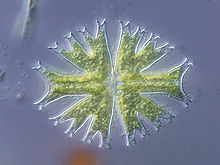Desmidiales
| Desmids | |
|---|---|
 |
|
| Micrasterias furcata | |
| Scientific classification | |
| (unranked): | Archaeplastida |
| Kingdom: | Plantae |
| Division: | Charophyta |
| Class: | Zygnematophyceae |
| Order: | Desmidiales |
| Families | |
Closteriaceae
Desmidiaceae
Gonatozygaceae
Peniaceae
Desmids (Gr. desmos, bond or chain) are an order (Desmidiales) in the Charophyta, a division of green algae that forms a sister group to the land plants (Embryophyta).
The desmids are often treated as members of the Zygnematales, as family Desmidiaceae. The Desmidiales comprise around 40 genera and 5,000 to 6,000species, found mostly but not exclusively in fresh water. Many species may be found in the fissures between patches of sphagnum moss in marshes. With a pH level of approximately 4.0, sphagnum peat provides the ideal environment for this flora.
The structure of these algae is unicellular, while the cell is sometimes divided into two symmetrical compartments separated by a narrow bridge or isthmus, wherein the spherical nucleus is located. Each semi-cell houses a large, often folded chloroplast for photosynthesizing. One or more pyrenoids can be found. These form carbohydrates for energy storage. The cell-wall, of two halves (termed semicells), which, in a few species of Closterium and Penium, are of more than one piece, has two distinct layers, the inner composed mainly of cellulose, the outer is stronger and thicker, often furnished with spines, granules, warts et cetera. It is made up of a base of cellulose impregnated with other substances including iron compounds, which are especially prominent in some species of Closterium and Penium and is not soluble in an ammoniacal solution of copper oxide.
...
Wikipedia
